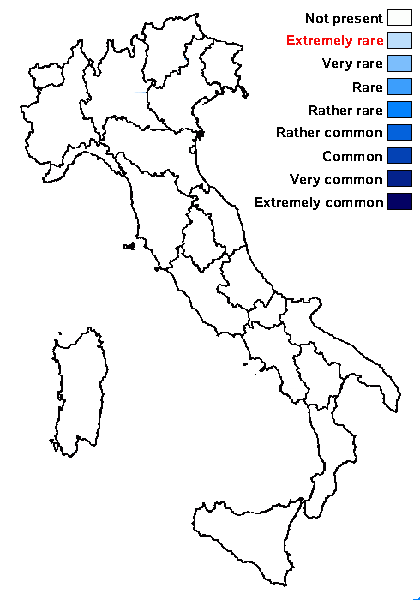Andreiomyces obtusaticus (Tønsberg) B.P. Hodk. & Lendemer
Mycosphere, 4, 6: 1036, 2013. Basionym: Lepraria obtusatica Tønsberg - Sommerfeltia, 14: 204, 1992
Synonyms:
Distribution:
Description: Thallus crustose to subleprose, pale yellowish green becoming more distinctly yellow-grey in the herbarium, diffuse and poorly delimited, forming irregular, up to several cm wide patches, entirely consisting of soredia-like, very fragile, up to 25(-35) μm wide, non-pseudocorticate granules without projecting hyphae, mixed with colourless hyphae, the granules sometimes loosely gathered into up to 50 μm wide aggregates (consoredia). Medulla absent or very poorly developed; hypothallus absent. Photobiont chlorococcoid, the cells up to 10 μm wide. Spot tests: K-, C-, KC-, P-, UV-, rarely P+ yellow, UV+ dull pink (from a single sample from Norway). Chemistry: obtusatic acid plus an unidentified yellow pigment (major), norobtusatic acid (minor), rarely with traces of barbatic acid.Note: on bark, rarely also on other substrata in shaded situations, mostly in rain-sheltered positions, in areas with suboceanic climates; apparently not common throughout its distributional range but perhaps overlooked or confused with Lepraria-species; most records are from Western Europe, but there are also a few records from the Alps (France, Switzerland). To be looked for in Italy. For further information see Tønsberg (1992) and Hodkinson & Lendemer (2013).
Growth form: Crustose
Substrata: bark
Photobiont: green algae other than Trentepohlia
Reproductive strategy: mainly asexual, by soredia, or soredia-like structures (e.g. blastidia)
Most common in areas with a humid-warm climate (e.g. most of Tyrrenian Italy)
In underhangs rarely wetted by rain

Predictive model
Growth form: Crustose
Substrata: bark
Photobiont: green algae other than Trentepohlia
Reproductive strategy: mainly asexual, by soredia, or soredia-like structures (e.g. blastidia)
Most common in areas with a humid-warm climate (e.g. most of Tyrrenian Italy)
In underhangs rarely wetted by rain

Predictive model
 Index Fungorum
Index Fungorum
 GBIF
GBIF


